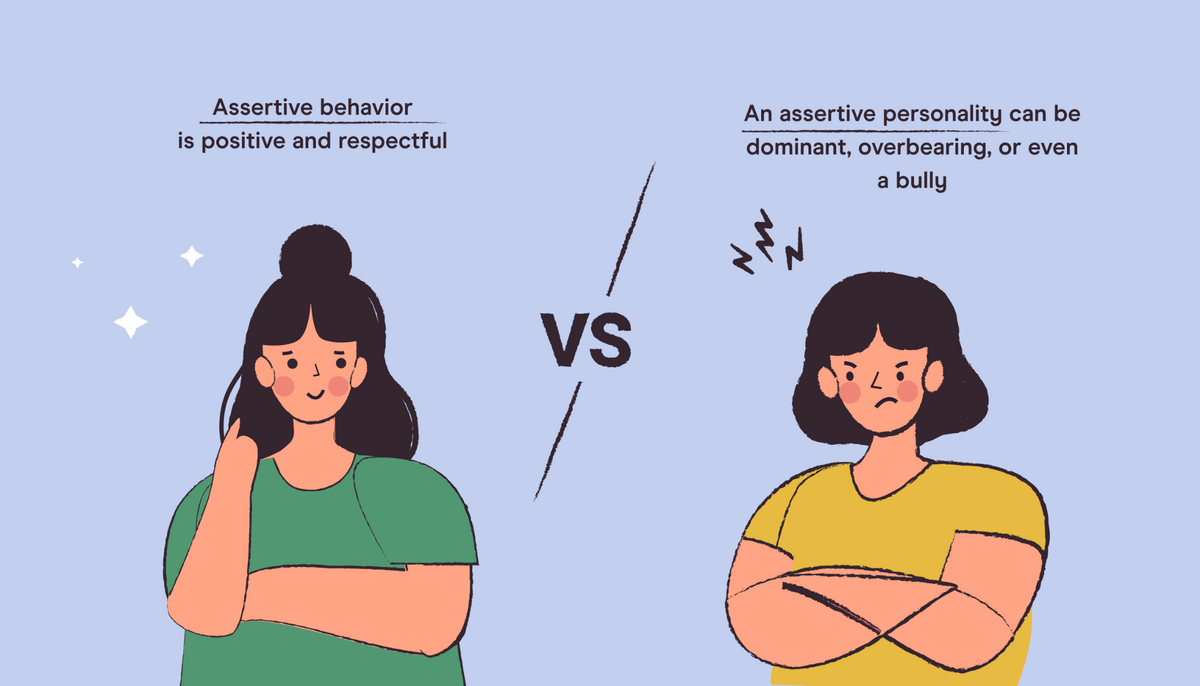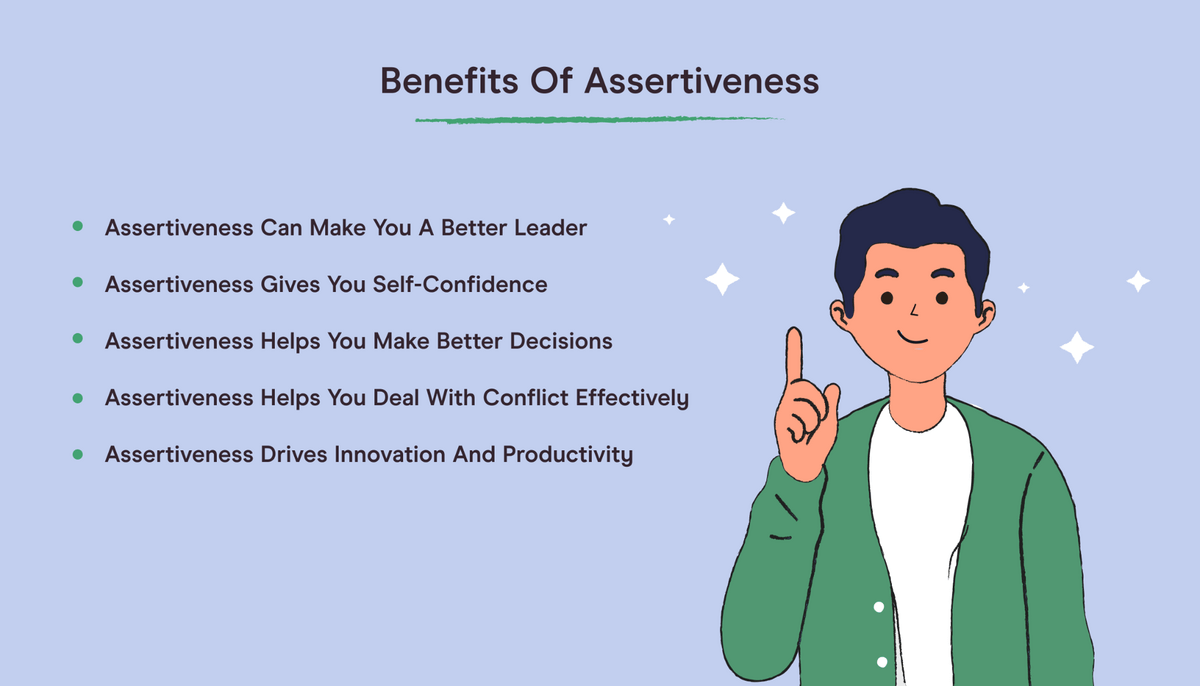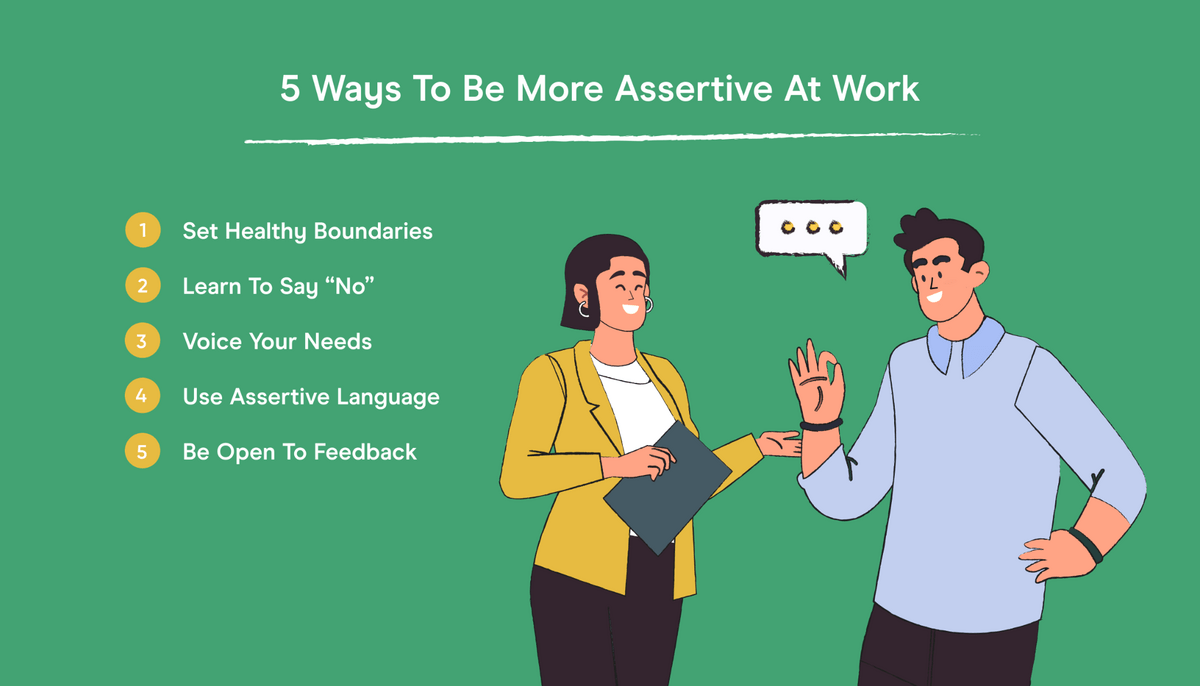Do you struggle with being assertive? Maybe you hold back from expressing your needs or opinions for fear of how people might react.
Or perhaps you’re the opposite. You can express your needs but struggle to do so in a calm and objective manner.
Either way, failing to use assertive communication can knock your self-confidence and negatively impact your work. If that’s the case, then you may benefit from assertiveness training.
Let’s dive into what assertiveness is, why it matters in the workplace, how assertiveness training can help you, and five ways to be more assertive.
What is assertiveness?
Assertiveness means defending your personal rights and boundaries or those of others without losing your cool or being aggressive.
When someone is assertive, they stay calm and positive, avoid raising their voice or upsetting others, and don’t get upset themselves. They use logic and rationale to defend their position rather than emotions, and they speak honestly about their beliefs or opinions.
Assertive communication is the opposite of being passive and just accepting something even when you don’t agree with it.
Many of us have learned to be passive as a result of negative experiences we might have had in the past. These experiences can make us feel less confident in ourselves and cause us to struggle to defend our boundaries.
Assertiveness is also different from aggression. Assertiveness is about striking a balance between protecting your needs and rights and considering those of others. It also means encouraging others to share honestly in order to find the best possible solution for all.
Aggressive behavior does not take into consideration the needs, rights, feelings, or beliefs of others. Aggression is based on winning at others’ expense.
Passive vs. aggressive vs. assertive
To illustrate the difference between the three concepts, consider the following example.
You wake up one morning with a to-do list longer than your arm. You have a sick kid, an empty fridge, and a big presentation to prepare for tomorrow.
As you juggle a doctor’s visit with getting your other child to school and rearranging your schedule of virtual meetings for the day, your partner walks in and asks you to pick up their dry cleaning for them.
What would you say?
- Passive response: “Sure, honey, I’ll do it later.”
- Aggressive response: “Can’t you see how much I’m dealing with here? You’re so inconsiderate! Why don’t you ever do anything for yourself?”
- Assertive response: “Sorry, but I’ve got way too much on my plate. You’ll have to do it yourself. And could you pick up dinner on the way back, too, please?”

What’s the difference between assertive behavior and an assertive personality?
In the Myers-Briggs personality theory, assertive personalities are calm and confident.
They are resilient to stress and take both success and failure in stride. They are confident in their abilities and decisions, and external criticism doesn’t faze them. Assertive personality types rarely lose their cool.
93% percent of people with this personality trait say they feel confident in facing life’s challenges and unknowns, compared to just 62% of their counterpart, the turbulent personality type.
People with assertive personalities have a naturally assertive communication style. This can be grating for those who are used to being more passive, as everything is up for friendly debate with an assertive personality type.
Fortunately, assertive behavior is something you can learn, even if you’re not a naturally assertive person.

Whether you tend to be more passive or more aggressive, this is behavior that you learned at some point in your life. This means you will also be able to unlearn those old patterns and learn new, more assertive behaviors.
Through learning assertive behaviors, you can develop an assertive personality.
Examples of assertive behavior at work
One of the places people often struggle to be assertive is at work. Maybe you were taught not to question authority (passive), or perhaps you’re the quintessential rebel (aggressive).
Either way, here are some examples of assertive behavior at work to help inspire your transformation:
- Asking for a raise
- Politely saying “no” to additional tasks
- Not letting people interrupt you
- Having a difficult conversation with a team member about their behavior
- Speaking out against discrimination
- Asking a colleague to do their part of a project
- Taking responsibility for your mistakes
- Asking your team for input before making a decision

Five benefits of assertiveness at work
Assertiveness is a core communication skill, but what are the benefits of being more assertive at work? Let’s take a look at five ways learning to be more assertive can benefit both you and your organization.

1. Makes you a better leader
For those in a leadership position, assertive communication and behavior are non-negotiables.
An assertive communication style allows you to deliver your message with calmness, clarity, and confidence while controlling your emotions.
This helps you win the respect of your team, develop better relationships with them, and create win-win situations.
2. Gives you self-confidence
Work involves challenges by nature. Perhaps you have a boss or coworker who doesn’t respect your boundaries, or maybe you were passed up for a promotion that you know you deserved.
Being assertive in a situation like this can help reduce the stress and anxiety that a passive or aggressive response might cause you to feel.
This can give you the confidence to face the problem head-on. You might confront your coworker (assertively) about their behavior. Or maybe you decide to talk to your boss, explaining your point of view in a calm and objective manner.
No matter the outcome, you’ll feel better knowing that you’ve expressed your truth in a non-aggressive way.
3. Helps you make better decisions
When you’re assertive, you’re sure of yourself and have confidence in your knowledge and ability to make the right decisions.
However, an assertive leader also knows the importance of seeking input from their team and is not afraid to do so. This allows them to take into account factors and perspectives they wouldn’t be aware of otherwise and make better decisions.
4. Helps you deal with conflict effectively
Whether you’re the one involved in the conflict or a leader dealing with conflict between two employees, assertiveness will help defuse the tension and lead toward a resolution.
Assertive communication during conflict means maintaining a calm demeanor, keeping your voice steady, and appealing to logic by using facts to support your argument.
5. Drives innovation and productivity
Assertive leadership creates a safe working environment in which employees feel free to speak up and contribute their ideas and opinions without fear of the consequences.
This can boost team morale, leading to higher employee engagement, more creativity, and higher productivity, all of which can ultimately benefit the organization.
How to be assertive without being aggressive
If you’re ready to start being more assertive, but you’re not sure how to do so without appearing aggressive, try the following tips.
- Be clear about your request: Be direct and honest about your feelings or opinions and use a normal conversational tone.
- Use non-aggressive body language: Avoid crossing your arms or moving them in a way that could come across as aggressive. Maintain a respectful distance from the other person.
- Make eye contact: Don’t look around the room or down at the floor, but also don’t stare, as this may appear aggressive.
- Keep your tone of voice steady: If you speak too low, it will seem like you lack confidence, but raising your voice will make you appear aggressive.
- Wait until you feel calm: If you’re upset or angry about something, it’s best to wait until the raw emotion subsides and you’re able to be more objective about the situation.
- Focus on behavior rather than people: If someone fails to turn in an assignment on time, don’t mark them up as “lazy.” Instead, try to get to the root cause of the problem.
Unfortunately, gender stereotypes often make people perceive assertive women as “bossy” or even “hysterical.” So, women should be aware that people may still perceive them as aggressive, even when they’re just assertive.
What is assertiveness training?
An assertiveness training program can help employees and leaders gain more confidence in themselves. It can be especially helpful for those who struggle to put their needs before the needs of others or those who often don’t believe that their ideas have value.
However, it’s also useful for those with more aggressive personalities to attend assertiveness training and learn assertive communication skills.
As well as improving assertiveness skills, assertiveness training prepares participants to handle difficult situations without losing their composure or becoming passive.
It teaches people that their needs matter, but so do the needs of others. In this type of training, people learn how to prioritize their own rights and needs without infringing on those of others. It also provides them with assertive techniques they can apply in different situations.
At the end of an assertiveness training program, participants should know how to communicate their needs and feelings in a non-confrontational way.
Five ways to be more assertive at work
Now that you know the importance of assertiveness at work and the difference between assertiveness and aggression, it’s time to put it into practice.
Use these five practical tips to start being more assertive at work today.

1. Set healthy boundaries
The first step to becoming more assertive is setting boundaries. This means being familiar with your beliefs, values, and priorities and knowing which you wish to defend.
For example, this could look like letting your boss know you won’t be available to do overtime because your priority is spending time with your family.
2. Learn to say “no”
It can be hard to say no — especially for those of us who are prone to people-pleasing. But saying no is vital for your sanity, well-being, and performance at work.
It’s how you enforce the boundaries you set. So, when your boss asks you to work overtime, even though you told them you wanted to spend time with your family, your answer should be “no.”
3. Voice your needs
Learn to express both your needs and opinions in a positive way. Even if you’re dealing with a negative issue, it’s important to approach it constructively.
So, instead of complaining about your colleague eating their lunch at their desk next to you, explain to them why it’s unhygienic and that you would prefer them to eat in the lunchroom.
4. Use assertive language
If you’re not used to being assertive, you’ll need to get familiar with assertive language.
Some examples include:
- Empathy: Do your best to understand and acknowledge the other person’s feelings.
- Asking for more time before you reply: This can help you avoid emotional outbursts.
- “I” statements: These help you keep the focus on your feelings rather than becoming accusatory.
- Escalate: If being assertive doesn’t yield the desired outcome, you may have to raise it with HR or someone in the hierarchy.
- Change your verbs: Try using “will” instead of could, should, and want to.
5. Be open to feedback
It’s not always easy to be on the receiving end of criticism, but try to accept it with grace. Rather than taking it personally, consider the feedback from an objective point of view and evaluate whether it is valid.
Assertiveness training can take your career to the next level
Assertiveness is a key leadership skill that anyone can benefit from learning.
Not only does being assertive boost your confidence, but it also improves your interpersonal relationships and boosts your productivity and performance at work.
And, if you occupy a leadership role (or aspire to one), then assertiveness training is non-negotiable.
Assertive leaders earn the respect of both their teams and their superiors. They also help boost employee engagement and productivity, which means executives are on the lookout for assertive leaders to promote.
Enrolling in a management course can boost your confidence and help you learn to be more assertive at work. Try out our High Output Management course today.
Pareto Labs offers engaging on demand courses in business fundamentals. Built to help you elevate your game at work, our courses distill complex business topics — like how to read financial statements, how to manage people, or even how to value a business — into digestible lessons. No business background required. Our library of 200+ lessons will teach you exactly what you need to know to use it at work tomorrow. Sign up for a free trial today to start watching.

